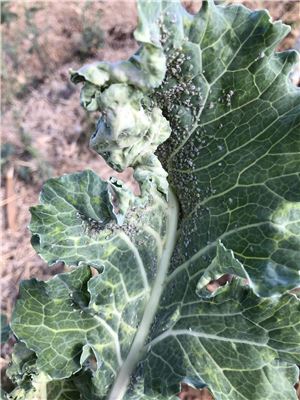United Kingdom
September 13, 2019
A team of international scientists from CABI, the Kenyan Agricultural and Livestock Research Organisation (KALRO), NIAB EMR (UK), University of Warwick (UK) and Syngenta (Netherlands) are seeking to improve the resistance of Kenya’s cabbage and kale crops to Turnip mosaic virus (TuMV).
In the distantly-related Chinese cabbage (Brassica rapa), a potentially durable TuMV disease resistance trait was identified by Professor John Walsh at the University of Warwick, while work by Dr Charlotte Nellist, of NIAB EMR, UK, Dr Bill Briggs, of Syngenta, and Prof Walsh elucidated the novel mechanism of TuMV resistance.
The scientists are now working to employ conventional breeding methods to move the resistance trait from Chinese cabbage to Kenyan cabbage and kale varieties in the anticipation that providing durable disease resistance in Kenyan cabbage and kale cultivars will help reduce yield losses.

Necrotic spotting symptoms of a cabbage head associated with TuMV infection. Photo credit: J. Walsh
The lower cost of production, the researchers believe, will hopefully result in cheaper retail prices – making the crops more available for consumption and helping in the fight against malnutrition.
In addition, the project aims to survey the prevalence of TuMV from multiple regions in Kenya and provide data on the efficacy of the Chinese cabbage resistance against contemporary Kenyan TuMV isolates.
Miriam Otipa, Head of Pathology at KALRO, said, “KALRO is excited to be part of this team that is solving a challenge for an important Kenyan vegetable that has not been tackled by any one so far in Kenya. The training of scientists in the use of modern molecular tools to breed for resistance is an area that is challenging for the organisation. The collaboration will foster the exchange of ideas among scientists from the UK and Kenya, thus enriching their knowledge.”

Turnip mosaic virus aphid vectors (Brevicoryne brassicae, ‘cabbage aphid’) present in substantial numbers in a kale crop, Subukia, Nakuru, Kenya. Photo credit: C. Nellist.
The project kicked off with a field sampling trip in March 2019, visiting four cabbage and kale growing regions of Kenya; Kinangop, Kinale, Subukia and Molo. The virus was detected in all four regions visited to varying degrees, with higher incidence in Subukia and Molo.
In addition, aphid vectors were observed at every individual farm visited across the four regions. TuMV isolates have been collected and are currently being screened on the Chinese cabbage resistant material to ensure the resistance is functional against Kenyan isolates of TuMV.
A crossing programme has been designed to transfer the resistance from the Chinese cabbage to cabbage and kale and will employ embryo rescue techniques to deal with incompatibility issues faced when crossing two different species.
Dr Joseph Mulema, Senior Scientist based at CABI in Kenya, said, “This project is line with CABI’s international development agenda and outputs from this work will be used in developing fit-for purpose information materials for use by smallholder farmers growing brassicas in Kenya.
“In addition, there will be a wider reach for these materials because they will also be added to the Plantwise Knowledge Bank, the online resource of the Plantwise Programme.”
Additional information
The project was funded through the Community Network for African Vector-Borne Plant Viruses (CONNECTED), which is financed by the UK Government’s Biotechnology and Biological Sciences Research Council (BBSRC), through the Global Challenges Research Fund (GCRF).
For more information visit the project page.
Project partners
- Dr. Charlotte F. Nellist (NIAB EMR, UK)
- Ms Miriam Otipa (KALRO, Kenya)
- Prof John A. Walsh (University of Warwick, UK)
- Dr Joseph Mulema (CABI, Kenya)
- Dr Bill H. Briggs (Syngenta, the Netherlands)
Relevant papers
Spence, N. J., Phiri, N. A., Hughes, S. L., Mwaniki, A., Simons, S., Oduor, G., Chacha, D., Kuria, A., Ndirangu, S. and Marris, G. C. (2007) Economic impact of Turnip mosaic virus, Cauliflower mosaic virus and Beet mosaic virus in three Kenyan vegetables. Plant Pathology 56, 317-323. DOI: 10.1111/j.1365-3059.2006.01498.x
Nellist, C. F., Qian, W., Jenner, C. E., Moore, J. D., Zhang, S., Wang, X., Briggs, W. H., Barker, G. C., Sun, R. and Walsh, J. A. (2014) Multiple copies of eukaryotic translation initiation factors in Brassica rapa facilitate redundancy, enabling diversification through variation in splicing and broad-spectrum virus resistance. The Plant Journal 77, 261-268. DOI: 10.1111/tpj.12389